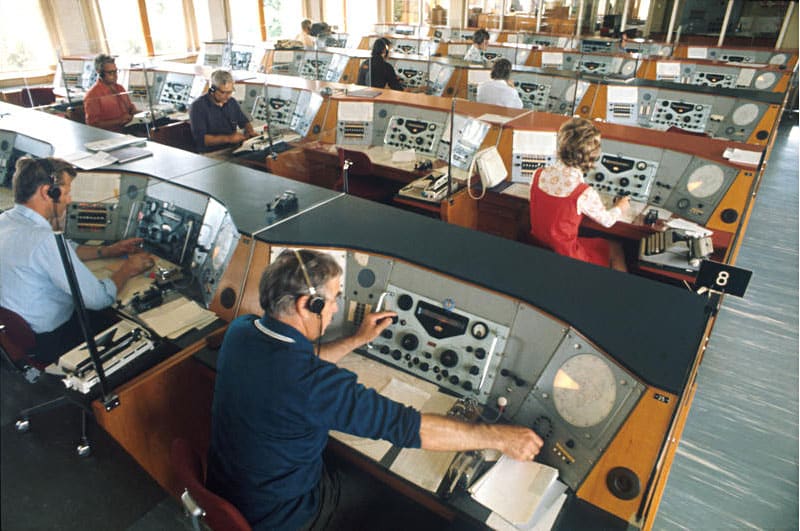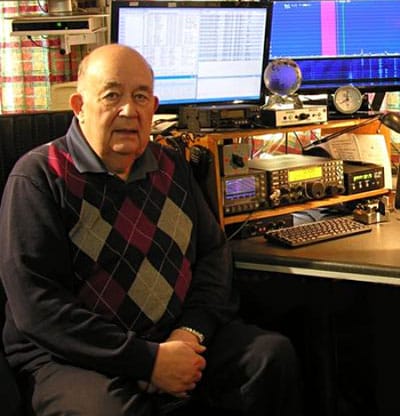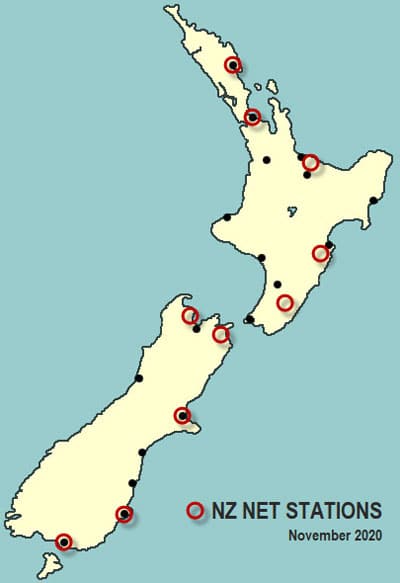This is a fortnightly newsletter about the New Zealand Net. If you would like to be notified by email when a new edition is published, please contact ZL1NZ.
Browse our newsletter archive.
Featured key

An early Vibro-keyer. Photo: KK4DSD
Vibroplex produced its first Vibro-keyers for use with electronic keyers in 1960. They were single-lever paddles, of course, as this was long before the development of iambic keying.
These keys, such as the one pictured above, had a jewel movement and red finger pieces, like the Deluxe line of Vibroplex bugs, but did not have a chromed base and were not marketed as ‘Deluxe.’ A version with a chromed base, introduced in 1961, became the Deluxe model, and the version above became the Standard model.
Nowadays, Vibroplex makes a Standard Vibrokeyer (the spelling was changed in the early 1980s), with black-painted base, black finger pieces and a choice of jewel or standard movement, as well as the Deluxe version and a version with gold-plated base.
Net numbers
In October we set a new monthly record with 188 check-ins. 🙂
We handled 33 radiograms, one less than the record we set in the previous month.
Stations checking in during October totalled 16, so our group is small but dedicated. It would be great to get more stations involved with the Net. We have, in months gone by, had 20 or more stations checking in at least once. So please help spread the word to any ops you think might be interested in the Net.

Here’s the monthly net report, which was sent to all stations during the 2 November net:
NR84 R ZL1NZ 41/38 AUCKLAND 0800Z 2NOV20 = NZ NET = OCTOBER QNI ZL1AJY 9 ZL1ANY 14 ZL1BWG 18 ZL1NZ 22 ZL1PC 4 ZL1RED 1 ZL2GD 18 ZL2GVA 16 ZL2KE 17 ZL2LN 7 ZL2WT 15 ZL4FZ 4 ZL4KX 3 ZL4LDY 11 VK3DRQ 21 VK4PN 8 TOTAL 188 QTC 33 = ZL1NZ
Making progress in CW
By Gerard ZL2GVA
I’ve been dabbling with CW for years (had to get the 12 wpm back in 1994 to get my HF license as PA3GMJ), but never got confident enough to do much with it.
The last few years I spent a bit more time on it, and participated in some of the local contests and Field Day, but still felt quite limited in my skills.
At the start of this year I decided to try and really tackle things, so I signed up for the Intermediate CW course that CW Ops run under their CW Academy programme. Unfortunately, there was no advisor available in our time zone, so things didn’t go ahead. Although disappointed, I decided to follow their curriculum by myself and improve a bit that way.
 In Sept/Oct the next course was due but, again, no advisor for our NZ time. However, after some email correspondence, one of the CW Academy managers, Joe AA8TA, very kindly offered me a weekly email check-in while I followed the curriculum, again on my own.
In Sept/Oct the next course was due but, again, no advisor for our NZ time. However, after some email correspondence, one of the CW Academy managers, Joe AA8TA, very kindly offered me a weekly email check-in while I followed the curriculum, again on my own.
This has been very good, as he gave me some good advice and guided me through several options to improve and, above all, it was an extra motivation to keep going.
At around the same time, I had made contact with Steve ZL2KE, who has been an advisor for the CW Academy in the past. He pointed me to the NZ Net, as a reliable and regular way to have some CW practice. So that’s how I ended up checking in for a couple of months now.
In the meantime, I was pleasantly surprised to recently receive the attached certificate from CW Academy, to say that I’d passed their Intermediate course! I didn’t expect that, as I hadn’t officially been in class. But it was very nice to get as an acknowledgment, and it also motivates me to try and get in the Advanced class for early next year.
I definitely have noticed CW getting easier, but head copy and head sending are still not easy to do.
Thanks very much to the NZ Net team for the opportunity to do some CW. It’s rather quiet on the bands otherwise for CW contacts.
Photo flashback

Radiotelegraph hall at Rogaland Radio receiving station in Skjæveland, Norway, 1974. Look at those awesome antenna direction indicators!
Morse musings
I’ve been thinking about a personal Morse objective for 2021. One that appeals to me is learning to key with my non-dominant hand. This would have a couple of advantages, I think:
- If arthritis or other disability were to affect my dominant hand, I would still be able to send Morse.
- I could send with one hand and write with the other. Think of all the time saved in never having to pick up or put down the pen!
While musing about this, I remembered an article from Morsum Magnificat:
TELEGRAPHIC AMBIDESTRY
Dick Johnson, Manager of RCA’s Marine Division at San Francisco, gave me my first RO job aboard the SS Lurline, WML, in 1925. I never saw him do it (others claim they had) but he allegedly could send a message with both hands simultanously – using American Morse with one hand and Continental Morse with the other. Frank Fisher of Lankin, Texas, says he doesn’t doubt it because of a personal experience he witnessed in a town near Salinas, Kansas (he’s forgotten the name). He says “I was standing by the ticket window waiting for a train (while watching) the agent—operator sending a bunch of manifests. While I was watching and listening he was called on another wire. Without pausing in his sending with his right hand, he opened the calling wire with his left hand, acknowledged, and closed the key, picked up a message blank, slipped it in his typewriter, rolled it into position and proceeded to copy that message with one long bony finger of his left hand, all the time continuing to send the manifests with his right hand.
[Total_Soft_Poll id=”2″]
Annual Bug Roundup later this month
Bug Roundup is an annual on-air event (not a contest) for users of semi-automatic keys. Sponsored by the Samuel F Morse Amateur Radio Club in Sacramento, California, this year’s Bug Roundup will be held from 0000 Saturday 21 Nov to 0000 Monday 23 Nov (dates/times are UTC) on all HF bands. Stations will be calling CQ BR.
Here’s a video from a couple of years ago with a member of the SFM club:
A New Zealand first
 A recent NZ Net Trivia question asked:
A recent NZ Net Trivia question asked:
“In November 1868 New Zealand telegraphists helped the country become the first in the world to do what?”
I thought that might be a tough one, but no, ZL1ANY and ZL2GVA had the answer the following evening.
New Zealand became the first country in the world to adopt a standard time – even before Britain with its famed Greenwich observatory.
And the telegraph system was the means for synchronising clocks at the nation’s post offices every day, in response to a signal from Wellington.
As he often does, David ZL2WT came up with a creative and entertaining response to the trivia question. He found a newspaper report from 1868 which expressed the opinion that politicians were going too far in demanding that people throughout the country use the same time!
Here’s David’s reply to the trivia question:
Pictured: Whanganui Post Office, c1905-1908
Low-band DXing author a silent key

John Develdore ON4UN, author of the well-known book Low-Band DXing, became a silent key on 9 Nov, at age 79.
John had worked an amazing 364 countries on 80m. The only one he never got was P5 (North Korea) which makes sense, as they have no active amateurs!
His 80m DX Handbook was published by Ham Radio magazine in 1977. In 1987 the ARRL asked him to write Low-Band DXing and I am pleased to have one of those first editions. The book is now available in an expanded 5th edition.
A keen CW operator, John was also the co-author of Ethics & Operating Procedures for the Radio Amateur, which was endorsed by the IARU.
Scrambled signals
On 22 Sep 1967, W1DM made a recording of the liner RMS Queen Mary in contact with a US coast station on 500 kHz.
The coast station (WSC) had QTC14 for Queen Mary (GBTT) but before taking the traffic GBTT sent the following informal message.
To win the virtual chocolate fish, all you need to do is be the first person to tell me where Queen Mary was when she sent this message. The info is in the message. Email your reply or send a radiogram to ZL1NZ via NZ Net.
Winner of the previous challenge
Paul ZL1AJY was quick to decode the morse message spelled out in a brick wall in Copenhagen. It read:
KAJPLADS 109 PKA ANNO 2015
indicating that the name of the building was Kajplads 109, and that it was built by a company called PKA in 2015.
Net tip: acting as a relay station
 This topic was suggested by a net member who wanted some tips on what they should do when acting as a relay station during the net. There are several aspects to this, so I’m going to do a series of posts over the next few newsletters.
This topic was suggested by a net member who wanted some tips on what they should do when acting as a relay station during the net. There are several aspects to this, so I’m going to do a series of posts over the next few newsletters.
Let’s start with some essentials that apply no matter what sort of relaying is being done, e.g. helping a weak station check in, providing fills on a piece of traffic or even forwarding an entire radiogram.
1. Be aware of relay opportunities, so you can assist when appropriate. What I do, even when another station is NCS, is keep a note of each station that checks into the net, along with their RST at my station, and any traffic they list. I also pay attention to what report they get from NCS, so I know if I’m copying them better or worse. I also take note if NCS says they are being troubled by QRN, etc., as this indicates they may request a relay at some point.
2. Only provide a relay if requested by the NCS.
3. But… don’t hesitate to inform NCS if you think your relay would be helpful in a specific situation.
4. While doing the relay, make it clear to everyone what is happening. For example, use callsigns frequently so it is clear who is being called and by whom.
5. When you’re finished relaying, turn things back over to NCS, e.g. using the “BTN” signal.
More to come in future newsletters. Please let me know if there are specific aspects of relaying that you would like me to cover.
Suggestions?
If you have suggestions on how to make the NZ Net better, or things you’d like to see covered in these updates, please contact ZL1NZ. You might even like to write something for the newsletter.
Thanks for reading, and I hope to see you soon on the NZ Net!
—
Neil Sanderson ZL1NZ, Net Manager
New Zealand Net (NZ NET)
3535.0 kHz at 9pm NZT Mon-Fri




